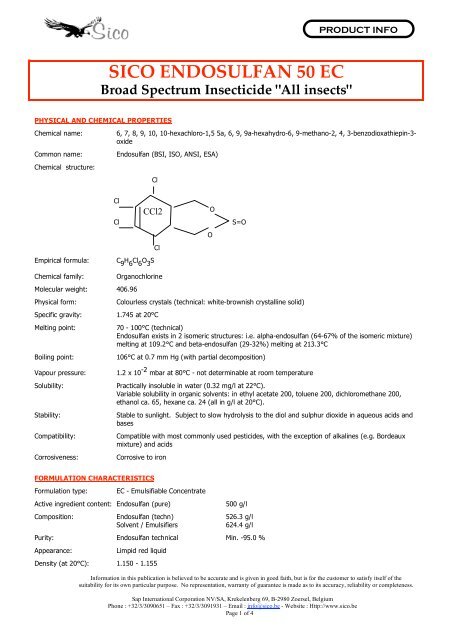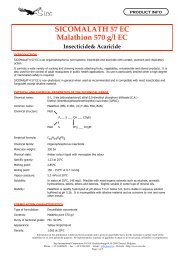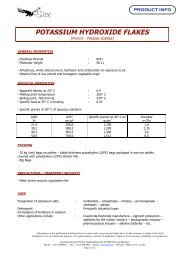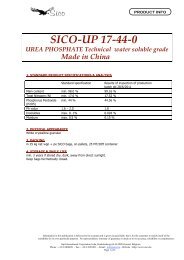SICO ENDOSULFAN 50 EC Broad Spectrum Insecticide "All insects"
SICO ENDOSULFAN 50 EC Broad Spectrum Insecticide "All insects"
SICO ENDOSULFAN 50 EC Broad Spectrum Insecticide "All insects"
You also want an ePaper? Increase the reach of your titles
YUMPU automatically turns print PDFs into web optimized ePapers that Google loves.
PRODUCT INFO<br />
<strong>SICO</strong> <strong>ENDOSULFAN</strong> <strong>50</strong> <strong>EC</strong><br />
<strong>Broad</strong> <strong>Spectrum</strong> <strong>Insecticide</strong> "<strong>All</strong> insects"<br />
PHYSICAL AND CHEMICAL PROPERTIES<br />
Chemical name:<br />
Common name:<br />
Chemical structure:<br />
6, 7, 8, 9, 10, 10-hexachloro-1,5 5a, 6, 9, 9a-hexahydro-6, 9-methano-2, 4, 3-benzodioxathiepin-3-<br />
oxide<br />
Endosulfan (BSI, ISO, ANSI, ESA)<br />
Cl<br />
Cl<br />
Cl<br />
CCl2<br />
O<br />
S=O<br />
O<br />
Cl<br />
Empirical formula:<br />
C 9<br />
H 6<br />
Cl 6<br />
O 3<br />
S<br />
Chemical family:<br />
Molecular weight: 406.96<br />
Physical form:<br />
Organochlorine<br />
Specific gravity: 1.745 at 20°C<br />
Melting point:<br />
Boiling point:<br />
Colourless crystals (technical: white-brownish crystalline solid)<br />
70 - 100°C (technical)<br />
Endosulfan exists in 2 isomeric structures: i.e. alpha-endosulfan (64-67% of the isomeric mixture)<br />
melting at 109.2°C and beta-endosulfan (29-32%) melting at 213.3°C<br />
106°C at 0.7 mm Hg (with partial decomposition)<br />
Vapour pressure:<br />
Solubility:<br />
Stability:<br />
Compatibility:<br />
Corrosiveness:<br />
1.2 x 10 -2 mbar at 80°C - not determinable at room temperature<br />
Practically insoluble in water (0.32 mg/l at 22°C).<br />
Variable solubility in organic solvents: in ethyl acetate 200, toluene 200, dichloromethane 200,<br />
ethanol ca. 65, hexane ca. 24 (all in g/l at 20°C).<br />
Stable to sunlight. Subject to slow hydrolysis to the diol and sulphur dioxide in aqueous acids and<br />
bases<br />
Compatible with most commonly used pesticides, with the exception of alkalines (e.g. Bordeaux<br />
mixture) and acids<br />
Corrosive to iron<br />
FORMULATION CHARACTERISTICS<br />
Formulation type:<br />
<strong>EC</strong> - Emulsifiable Concentrate<br />
Active ingredient content: Endosulfan (pure)<br />
<strong>50</strong>0 g/l<br />
Composition: Endosulfan (techn) 526.3 g/l<br />
Solvent / Emulsifiers<br />
624.4 g/l<br />
Purity: Endosulfan technical Min. -95.0 %<br />
Appearance:<br />
Limpid red liquid<br />
Density (at 20°C): 1.1<strong>50</strong> - 1.155<br />
Information in this publication is believed to be accurate and is given in good faith, but is for the customer to satisfy itself of the<br />
suitability for its own particular purpose. No representation, warranty of guarantee is made as to its accuracy, reliability or completeness.<br />
Sap International Corporation NV/SA, Krekelenberg 69, B-2980 Zoersel, Belgium<br />
Phone : +32/3/3090651 – Fax : +32/3/3091931 – Email : info@sico.be - Website : Http://www.sico.be<br />
Page 1 of 4
PRODUCT INFO<br />
Flash point (c.c.): Approx. + 27°C<br />
Emulsion characteristics:<br />
Stability:<br />
Shelf life:<br />
Initial emulsion stability and re-emulsification after 24 hours; easy, complete<br />
(conform to CIPAC methods)<br />
No significant change in the physico-chemical characteristics after accelerated aging test<br />
(14 days at 54°C +/- 1°C)<br />
Min. 2 years<br />
BIOLOGICAL SP<strong>EC</strong>TRUM<br />
Sico Endosulfan <strong>50</strong> <strong>EC</strong> is a broad spectrum non-systemic contact insecticide effective against numerous insects and certain<br />
mites attacking crops. Sico Endosulfan has a long-lasting effect, but is selective towards bees and other beneficial insects and<br />
birds. The insecticidal effect (contact and intestinal) is speeded up by high temperatures and high relative humidity. Flavour<br />
and odour of treated crops is not affected.<br />
Sico Endosulfan <strong>50</strong> <strong>EC</strong> gives good insecticidal control of aphids, thrips, beetles, cutworms, bollworms, foliar feeding larvae,<br />
mites, bugs borers, whitefly, slugs and leafhoppers in a very wide range of crops, including fruit, field and industrial crops,<br />
vegetables, ornamentals and forestry. It controls also termites and tsetse flies.<br />
METHOD OF APPLICATION<br />
This product is an emulsifiable concentrate ready to be mixed into water just before application with conventional dilute<br />
ground sprayers. Add the required amount of the product to half-filled spray tank and agitate while adding the remaining water.<br />
Apply the solution immediately after mixing.<br />
The spray concentration depends on the type of spray equipment, the crop, the infestation pressure and the local experience.<br />
Since Endosulfan <strong>50</strong> <strong>EC</strong> has no systematic action, good foliage coverage should be observed especially against aphids.<br />
Apply when the first signs of infestation appear. Repeat whenever necessary, at 8-14 days intervals.<br />
Adjust the recommended rates according to the development of the crop, the kind of infestation pressure of the pest and its<br />
location on the plants. Follow the dosage rates per ha or per lh listed in the table hereafter.<br />
RATES OF APPLICATION<br />
The rates of application varies according to pests, crops and local conditions. The following figures may serve as an<br />
indication. Do not exceed the maximum rates per ha.<br />
Pre-harvest intervals:<br />
Vegetables (general) - 7 days<br />
Blueberries, cauliflower, lettuce, cotton - 14 days<br />
Cherries, plums, prune - 21 days<br />
Apple, peach, pear, sugar beet - 30 days<br />
Follow the directions of local authorities.<br />
Maximum residue level: Vegetables - 2 ppm<br />
Cabbage, beans - 0.5 ppm<br />
Carrots, potatoes, onion - 0.2 ppm<br />
Rice, beet - 0.1 ppm<br />
Tea - 30 ppm<br />
Crops Insect pests<br />
Rates of application<br />
Fruit trees Blossom weevils, leafweevil, aphids, 100 - 140 ml/hl<br />
Apple, pear, plum lacky moths, psylla, mites, wooly aphids.<br />
Peach Peach twig and tree borer. 140 - 175 ml/hl<br />
Citrus Bollworms, moth, thrips, ants, aphids 100 - 140 ml/hl<br />
whitefly, citrus psylla.<br />
Vegetables Bollworms, armyworms, loopers, cabbage 100 - 140 ml/hl<br />
Tomato, peas, cucumber, worm, cabbage moth, bean beetle, thrips,<br />
cabbages, lettuce, carrot, flea beetle, aphids, colorado beetle, white<br />
etc.<br />
fly, lygus bug, stink bug, mites, many others.<br />
Cotton Bollworms, cotton leafworm, boll weevil, 1 - 2.8 l/ha<br />
cotton aphid, mites, leafhoppers, etc.<br />
Information in this publication is believed to be accurate and is given in good faith, but is for the customer to satisfy itself of the<br />
suitability for its own particular purpose. No representation, warranty of guarantee is made as to its accuracy, reliability or completeness.<br />
Sap International Corporation NV/SA, Krekelenberg 69, B-2980 Zoersel, Belgium<br />
Phone : +32/3/3090651 – Fax : +32/3/3091931 – Email : info@sico.be - Website : Http://www.sico.be<br />
Page 2 of 4
PRODUCT INFO<br />
Tobacco Tobacco budworm, flea beetle, grasshop- 0.6 - 1 l/ha<br />
pers, loopers, thrips, aphids, bollworms,<br />
armyworms, etc.<br />
Corn, sugar cane, sorghumStem borere, sugar cane froghopper, aphids,<br />
bollworms and many others.<br />
1 - 2.1 l/ha<br />
Coffee Clear-wing hawk moth, coffee bugs, 1.4 - 2.1 l/ha<br />
epicampoptera spp., lygus bugs,<br />
lace-wing bugs, stem borer.<br />
Rice Stem borer, armyworms, rice sting bug, 1 - 1.4 l/ha<br />
rice planthopper.<br />
Tea Tea mosquito bug, thrips, helopeltis 0.85 - 1.4 l/ha<br />
spp., mites.<br />
Moderately dangerous to bees: Recommended to avoid treatment during flowering!<br />
TOXICOLOGY<br />
Active ingredient:<br />
Endosulfan<br />
Acute oral LD<strong>50</strong> (rats):<br />
110 mg/kg<br />
Acute oral LD<strong>50</strong> (dogs):<br />
77 mg/kg<br />
Acute dermal LD<strong>50</strong> (rabbits): 360 mg/kg<br />
Acute dermal LD<strong>50</strong> (female rats): 74 mg/kg<br />
Acute dermal LD<strong>50</strong> (guinea pigs): > 1000 mg/kg<br />
Acute inhalation LC<strong>50</strong> (lh) (rats): > 21 mg/l air<br />
Eye irritation (rabbits):<br />
Non-irritant in washed eye<br />
Eye irritation (rabbits):<br />
Low irritant in non washed eye<br />
Skin irritation (rabbits):<br />
Non-irritating<br />
Chronic toxicity<br />
NOEL 2-y feeding trials (rats): 30 mg/kg daily<br />
NOEL 2-y feeding trials (dogs): 30 mg/kg daily<br />
Acceptable daily intake for man: 0.006 mg/kg bw<br />
Toxicity for fish:<br />
Highly toxic<br />
LC<strong>50</strong> (48h) trout fry:<br />
0.01 mg/l<br />
LC<strong>50</strong> (48h) minor carp:<br />
0.011 mg/l<br />
Toxicity to birds:<br />
Low toxicity<br />
LD<strong>50</strong> mallard duck:<br />
200 - 7<strong>50</strong> mg/kg<br />
Toxicity to bees:<br />
Low toxicity<br />
Formulation:<br />
Acute oral (calculated) LD<strong>50</strong> (rats): 220 mg/kg<br />
Acute dermal (calculated) LD<strong>50</strong> (rats):720 mg/kg<br />
Eye irritation (rabbits):<br />
Irritant<br />
Skin irritation (rabbits):<br />
Irritant<br />
Sensitisation (guinea pigs): Non-sensitizer<br />
Toxicity to fish:<br />
Toxic<br />
Toxicity to bees:<br />
Low hazard in fields. Nevertheless, advise not to spray at blossom time.<br />
Information in this publication is believed to be accurate and is given in good faith, but is for the customer to satisfy itself of the<br />
suitability for its own particular purpose. No representation, warranty of guarantee is made as to its accuracy, reliability or completeness.<br />
Sap International Corporation NV/SA, Krekelenberg 69, B-2980 Zoersel, Belgium<br />
Phone : +32/3/3090651 – Fax : +32/3/3091931 – Email : info@sico.be - Website : Http://www.sico.be<br />
Page 3 of 4
PRODUCT INFO<br />
SAFETY PR<strong>EC</strong>AUTION<br />
The formulated product is harmful if swallowed, by contact with skin or by inhalation and irritant to skin and eyes.<br />
Observe also the general rules for handling the crop protection chemicals:<br />
- Keep out of reach of children, away from food, drink or feed.<br />
- Wear suitable protective clothing, gloves, goggles and face shield.<br />
- When using, do not eat, drink or smoke.<br />
- Wash any contamination from skin or eyse immediately.<br />
- Do not breathe spray mist.<br />
- Wash hands and exposed skin before eating, drinking or smoking, before meals and after work.<br />
- If you feel unwell, seek medical advice (show label where possible).<br />
Storage and disposal:<br />
- Store in the original container, thightly closed, in a cool, well ventilated and locked local, protected heat, away from food or<br />
feed.<br />
- Do not reuse the container for any other purpose but destroy rinsed container by puncturing and crushing.<br />
- Toxic to fish and wildlife: do not contaminate ponds, waterways or ditches with chemical or used container.<br />
EMERGENCY GUIDELINES<br />
Symptoms of poisoning:<br />
The effects of poisoning are headaches, nausea, vomiting, anxiety, prickling sensation on the top of the tongue, upper lip and<br />
the chin region, stiffness and pain in the jaw; in very severe cases convulsions with exitus.<br />
First aid:<br />
- In case of skin contact, remove all contaminated clothing and wash the patient thoroughly with plenty of water and soap.<br />
- In case of eye contact, flush eyes with copious amounts of water for at least 15 minutes.<br />
- If product has been swallowed, gastric lavage should be carried out. Keep the patient at absolute rest and seek medical<br />
assistance immediately.<br />
Note to physician:<br />
No specific antidote, symptomatic treatment. Establish clear air way if necessary by controlled respiration.<br />
If swallowed, administer 200 ml of liquid paraffin followed by gastric lavage taking care to prevent aspiration into lungs. For<br />
convulsions drug of choice is Diazepam. Maintain general surveillance at least 2 days.<br />
Contraindications: Epinephrine Derivates.<br />
Every endeavour has been made to ensure that the information given herein is true and reliable but it is given only for the guidance of our customers.<br />
Sap International cannot accept any responsibility for loss or damage or infringement of patent rights, that may result from the use of<br />
information, due to the possibility of variations of processing or working conditions and of workmanship outside our control. Users are advised<br />
to confirm the suitability of the products with their own tests.<br />
Information in this publication is believed to be accurate and is given in good faith, but is for the customer to satisfy itself of the<br />
suitability for its own particular purpose. No representation, warranty of guarantee is made as to its accuracy, reliability or completeness.<br />
Sap International Corporation NV/SA, Krekelenberg 69, B-2980 Zoersel, Belgium<br />
Phone : +32/3/3090651 – Fax : +32/3/3091931 – Email : info@sico.be - Website : Http://www.sico.be<br />
Page 4 of 4
















